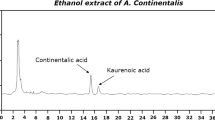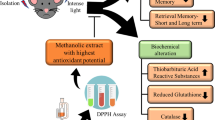Abstract
Post-traumatic stress disorder (PTSD) is precipitated by exposure to severe traumatic events such as wars, natural disasters, catastrophes, or other traumatic events. Withania somnifera (WS) Dunal (family: Solanaceae) known traditionally as “Ashwaghanda” is used widely in ayurvedic medicine, and known to have positive role in neurodegenerative diseases. In this study, WS effect on impairment of memory due to PTSD was studied in animal models. Single-prolonged stress rat model, which consisted of restrain for 2 h, forced swimming for 20 min, rest for 15 min, and diethyl ether exposure for 1–2 min, was used to induce PTSD animals. The WS root powder extract was administered orally at a dose of 500 mg/kg/day. The radial arm water maze (RAWM) was used to assess spatial learning and memory. Enzymatic assays were used to evaluate changes in oxidative stress biomarkers in the hippocampus following treatments. The result showed that PTSD resulted in short- and long- term memory impairments. Administration of WS prevented this impairment of memory induced by PTSD. Furthermore, WS prevented PTSD induced changes in oxidative stress biomarker in the hippocampus. For quality assessment, the methanolic extract for WS was subjected to UHPLC analysis. A calibration curve for isowithanone as a marker compound was constructed. WS roots content of isowithanone was found to be 0.23% (w/w). In conclusion, WS administration prevented PTSD induced memory impairment probably through preserving changes in antioxidant mechanisms in the hippocampus.




Similar content being viewed by others
References
American Psychiatric Association (2013) Diagnostic and Statistical Manual of Mental Disorders (DSM-5), 5th edn. American Psychiatric Association, Washington, DC
Galea S, Nandi A, Vlahov D (2005) The epidemiology of post-traumatic stress disorder after disasters. Epidemiol Rev 27:78–91. https://doi.org/10.1093/epirev/mxi003
Andero R, Daviu N, Escorihuela RM, Nadal R, Armario A (2012) 7,8-Dihydroxyflavone, a TrkB receptor agonist, blocks long-term spatial memory impairment caused by immobilization stress in rats. Hippocampus 22:399–408. https://doi.org/10.1002/hipo.20906
Cohen H, Kaplan Z, Matar MA, Loewenthal U, Zohar J, Richter-Levin G (2007) Long-lasting behavioral effects of juvenile trauma in an animal model of PTSD associated with a failure of the autonomic nervous system to recover. Eur Neuropsychopharmacol 17:464–477. https://doi.org/10.1016/j.euroneuro.2006.11.003
Patki G, Li L, Allam F, Solanki N, Dao AT, Alkadhi K, Salim S (2014) Moderate treadmill exercise rescues anxiety and depression-like behavior as well as memory impairment in a rat model of posttraumatic stress disorder. Physiol Behav 130:47–53. https://doi.org/10.1016/j.physbeh.2014.03.016
Richter-Levin G (1998) Acute and long-term behavioral correlates of underwater trauma–potential relevance to stress and post-stress syndromes. Psychiatry Res 79:73–83
Solanki N, Alkadhi I, Atrooz F, Patki G, Salim S (2015) Grape powder prevents cognitive, behavioral, and biochemical impairments in a rat model of posttraumatic stress disorder. Nutr Res 35:65–75. https://doi.org/10.1016/j.nutres.2014.11.008
Wilson CB, McLaughlin LD, Nair A, Ebenezer PJ, Dange R, Francis J (2013) Inflammation and oxidative stress are elevated in the brain, blood, and adrenal glands during the progression of post-traumatic stress disorder in a predator exposure animal model. PLoS ONE 8:e76146. https://doi.org/10.1371/journal.pone.0076146
Kulkarni SK, Dhir A (2008) Withania somnifera: an Indian ginseng. Prog Neuropsychopharmacol Biol Psychiatry 32:1093–1105. https://doi.org/10.1016/j.pnpbp.2007.09.011
Bhattacharya SK, Muruganandam AV (2003) Adaptogenic activity of Withania somnifera: an experimental study using a rat model of chronic stress. Pharmacol Biochem Behav 75:547–555
Bhattacharya SK, Satyan KS, Ghosal S (1997) Antioxidant activity of glycowithanolides from Withania somnifera. Indian J Exp Biol 35:236–239
Gupta A, Singh S (2014) Evaluation of anti-inflammatory effect of Withania somnifera root on collagen-induced arthritis in rats. Pharm Biol 52:308–320. https://doi.org/10.3109/13880209.2013.835325
Archana R, Namasivayam A (1999) Antistressor effect of Withania somnifera. J Ethnopharmacol 64:91–93
Chandrasekhar K, Kapoor J, Anishetty S (2012) A prospective, randomized double-blind, placebo-controlled study of safety and efficacy of a high-concentration full-spectrum extract of ashwagandha root in reducing stress and anxiety in adults. Indian J Psychol Med 34:255–262. https://doi.org/10.4103/0253-7176.106022
Baitharu I, Jain V, Deep SN, Hota KB, Hota SK, Prasad D, Ilavazhagan G (2013) Withania somnifera root extract ameliorates hypobaric hypoxia induced memory impairment in rats. J Ethnopharmacol 145:431–441. https://doi.org/10.1016/j.jep.2012.10.063
Kuboyama T, Tohda C, Komatsu K (2014) Effects of Ashwagandha (roots of Withania somnifera) on neurodegenerative diseases. Biol Pharm Bull 37:892–897
Panossian A, Seo EJ, Efferth T (2018) Novel molecular mechanisms for the adaptogenic effects of herbal extracts on isolated brain cells using systems biology. Phytomedicine 50:257–284. https://doi.org/10.1016/j.phymed.2018.09.204
Shah J, Goyal R (2011) Investigation of neuropsychopharmacological effects of a polyherbal formulation on the learning and memory process in rats. J Young Pharm 3:119–124. https://doi.org/10.4103/0975-1483.80296
Tohda C, Kuboyama T, Komatsu K (2005) Search for natural products related to regeneration of the neuronal network. Neurosignals 14:34–45. https://doi.org/10.1159/000085384
Tripathi N, Shrivastava D, Ahmad Mir B, Kumar S, Govil S, Vahedi M, Bisen PS (2018) Metabolomic and biotechnological approaches to determine therapeutic potential of Withania somnifera (L.) Dunal: a review. Phytomedicine 50:127–136. https://doi.org/10.1016/j.phymed.2017.08.020
Saykally JN, Hatic H, Keeley KL, Jain SC, Ravindranath V, Citron BA (2017) Withania somnifera extract protects model neurons from in vitro traumatic injury. Cell Transplant 26:1193–1201. https://doi.org/10.1177/0963689717714320
Gannon JM, Forrest PE, Roy Chengappa KN (2014) Subtle changes in thyroid indices during a placebo-controlled study of an extract of Withania somnifera in persons with bipolar disorder. J Ayurveda Integr Med 5:241–245. https://doi.org/10.4103/0975-9476.146566
Kumar S, Seal CJ, Howes MJ, Kite GC, Okello EJ (2010) In vitro protective effects of Withania somnifera (L.) dunal root extract against hydrogen peroxide and beta-amyloid(1-42)-induced cytotoxicity in differentiated PC12 cells. Phytother Res 24:1567–1574. https://doi.org/10.1002/ptr.3261
Panda S, Kar A (1997) Evidence for free radical scavenging activity of Ashwagandha root powder in mice. Indian J Physiol Pharmacol 41:424–426
Gupta GL, Rana AC (2007) Protective effect of Withania somnifera dunal root extract against protracted social isolation induced behavior in rats. Indian J Physiol Pharmacol 51:345–353
Wang W et al (2008) A modified single-prolonged stress model for post-traumatic stress disorder. Neurosci Lett 441:237–241. https://doi.org/10.1016/j.neulet.2008.06.031
Singh N, Bhalla M, de Jager P, Gilca M (2011) An overview on ashwagandha: a Rasayana (rejuvenator) of Ayurveda. Afr J Tradit Complement Altern Med 8:208–213. https://doi.org/10.4314/ajtcam.v8i5s.9
Gautam A, Wadhwa R, Thakur MK (2013) Involvement of hippocampal Arc in amnesia and its recovery by alcoholic extract of Ashwagandha leaves. Neurobiol Learn Mem 106:177–184. https://doi.org/10.1016/j.nlm.2013.08.009
Dhuley JN (1998) Effect of ashwagandha on lipid peroxidation in stress-induced animals. J Ethnopharmacol 60:173–178
Kaur P, Mathur S, Sharma M, Tiwari M, Srivastava KK, Chandra R (2001) A biologically active constituent of withania somnifera (ashwagandha) with antistress activity. Indian J Clin Biochem 16:195–198. https://doi.org/10.1007/bf02864860
Singh N, Nath R, Lata A, Singh SP, Kohli RP, Bhargava KP (1982) Withania Somnifera (Ashwagandha), a rejuvenating herbal drug which enhances survival during stress (an adaptogen). Pharm Biol 20:29–35. https://doi.org/10.3109/13880208209083282
Walvekar M, Shaikh N, Sarvalkar P (2013) Effects of glycowithanolides on lipid peroxidation and lipofuscinogenesis in male reproductive organs of mice. Iran J Reprod Med 11:711–716
Allam F et al (2013) Grape powder supplementation prevents oxidative stress-induced anxiety-like behavior, memory impairment, and high blood pressure in rats. J Nutr 143:835–842. https://doi.org/10.3945/jn.113.174649
Bouayed J, Rammal H, Younos C, Soulimani R (2007) Positive correlation between peripheral blood granulocyte oxidative status and level of anxiety in mice. Eur J Pharmacol 564:146–149. https://doi.org/10.1016/j.ejphar.2007.02.055
de Oliveira MR, Silvestrin RB, Souza TM, Moreira JCF (2007) Oxidative stress in the hippocampus, anxiety-like behavior and decreased locomotory and exploratory activity of adult rats: effects of sub acute vitamin A supplementation at therapeutic doses. Neurotoxicology 28(6):1191–1199. https://doi.org/10.1016/j.neuro.2007.07.008
RajaSankar S, Manivasagam T, Sankar V, Prakash S, Muthusamy R, Krishnamurti A, Surendran S (2009) Withania somnifera root extract improves catecholamines and physiological abnormalities seen in a Parkinson’s disease model mouse. J Ethnopharmacol 125:369–373. https://doi.org/10.1016/j.jep.2009.08.003
Ven Murthy MR, Ranjekar PK, Ramassamy C, Deshpande M (2010) Scientific basis for the use of Indian ayurvedic medicinal plants in the treatment of neurodegenerative disorders: ashwagandha. Cent Nerv Syst Agents Med Chem 10:238–246
Diehl LA et al (2012) Long-lasting effects of maternal separation on an animal model of post-traumatic stress disorder: effects on memory and hippocampal oxidative stress. Neurochem Res 37:700–707. https://doi.org/10.1007/s11064-011-0660-6
Acheson DT, Gresack JE, Risbrough VB (2012) Hippocampal dysfunction effects on context memory: possible etiology for posttraumatic stress disorder. Neuropharmacology 62:674–685. https://doi.org/10.1016/j.neuropharm.2011.04.029
Acknowledgements
The study was funded by Grant No. 283/2014 to KA from the Deanship of Research of the Jordan University of Science and Technology.
Author information
Authors and Affiliations
Corresponding author
Additional information
Publisher's Note
Springer Nature remains neutral with regard to jurisdictional claims in published maps and institutional affiliations.
Rights and permissions
About this article
Cite this article
Alzoubi, K.H., Al Hilo, A.S., Al-Balas, Q.A. et al. Withania somnifera root powder protects againist post-traumatic stress disorder-induced memory impairment. Mol Biol Rep 46, 4709–4715 (2019). https://doi.org/10.1007/s11033-019-04915-3
Received:
Accepted:
Published:
Issue Date:
DOI: https://doi.org/10.1007/s11033-019-04915-3




